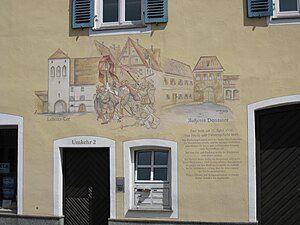Cross and flag battle
| date | 1606 / 1607 |
|---|---|
| place | Donauwörth |
| output | Imperial ban against Donauwörth ; Catholic victory |
| consequences | Donauwörth is in the duchy of Bavaria incorporated |
| Parties to the conflict | |
|---|---|
As a cross and flags battles two violent confrontations between are Catholics and Protestants , made up, in the former 1606 and 1607 imperial city Donauwörth have happened. As a result of these local disputes, Donauwörth was annexed by the Duchy of Bavaria , which in turn led to the establishment of the Protestant Union as a protective alliance for Lutheran and Calvinist imperial estates . The conflict over Donauwörth contributed to the tensions that sparked the Thirty Years' War in 1618 .
prehistory
The majority of the residents of Donauwörth had converted to Protestantism during the Reformation . The city's magistrate was also Protestant. When the tone between the followers of both denominations intensified again at the end of the 16th century as a result of the Catholic Counter-Reformation , there were increasingly religiously motivated disputes and disputes between the Protestant majority and the Catholic minority in Donauwörth. The Catholics were supported by the monks of the Benedictine monastery Heilig Kreuz on the outskirts .
Mark procession 1606
The first violent clash occurred on April 25, 1606. During the St. Mark's procession to the nearby village of Auchsesheim , five Benedictine monks and a small group of Catholics crossed the city singing and with waving flags. This display of Catholicism was legal under the provisions of the Augsburg Religious Peace , but it contradicted the practice in previous years.
The Protestant majority regarded the demonstrative appearance of the Catholics as a provocation. When the procession wanted to take the return route through the city, the city council refused entry through the city gate. Crossing the city is only permitted if the flags are rolled up and the singing ceases. A dispute between the denominational groups ensued, which ended in a fight. A notary of the Bishop of Augsburg recorded the incident. From his presence, some historians conclude that the procession was actually planned as a provocation.
The Bishop of Augsburg filed a lawsuit against Donauwörth with the Reichshofrat , using the notarial report as evidence. Emperor Rudolf II , himself a Catholic, threatened the city with the imperial ban if it did not respect the rights of its Catholic citizenship.
New procession and imperial ban
Despite this threat, the St. Mark's procession of the following year ended in tumult again. The participants in the procession were chased out of the city together with two Bavarian commissioners. Thereupon the Emperor imposed the imperial ban on Donauwörth on August 3, 1607 and commissioned the Bavarian Duke Maximilian I to enforce it.
Overestimating its own possibilities, the city council refused to even receive a negotiating delegation sent by Maximilian I. At the end of November 1607, the duke had a force of 15,000 men deployed in front of Donauwörth. The small imperial city, which then had about 4,000 inhabitants, surrendered in the face of the overwhelming power, and on December 17th the Bavarian troops occupied the place. Duke Maximilian had the city presented an astronomically high cost calculation that far exceeded its financial means. Since Donauwörth could not meet the monetary claims, the city remained in Bavarian lien, which in fact corresponded to an annexation by the neighboring duchy.
aftermath
The Donauwörth case contributed significantly to the exacerbation of denominational tensions in the empire . It is true that the Protestants Donauwörths put themselves in the wrong by obstructing the processions, but the execution of the imperial ban by the Bavarian Duke also happened against current imperial law. Since Donauwörth did not belong to the Bavarian , but to the Swabian imperial circle , the execution would have been the task of the Duke of Württemberg as the responsible district bishop . But this was a Protestant himself, so the emperor commissioned the Catholic Duke of Bavaria.
Maximilian I pursued a targeted re-Catholicization of the city in the following period . Therefore, a large part of the Protestant citizens left Donauwörth as a result of the Bavarian occupation, which led to the impoverishment of the city. Its annexation by Bavaria caused a sensation among Protestants all over Germany and contributed to the growing distrust between the faith groups. As a reaction to Donauwörth, some of the previously divided Protestant imperial estates founded the Protestant Union to counter further claims by the Catholic powers. Its leader was the Calvinist Elector Friedrich von der Pfalz , who after 1618, together with his Catholic cousin Maximilian von Bayern, contributed significantly to the outbreak of the Thirty Years' War .
literature
- Rainer A. Müller: Counter Reformation and the Thirty Years War 1555–1648 (Volume 4 of the book series “German History in Sources and Representations”) pp. 132–134.
- Maximilian Lanzinner : Donauwörth. The Bavarian reach for the imperial city 1607/1608. In: Alois Schmid / Katharina Weigand (eds.): Schauplätze der Geschichte in Bayern, page 216-230, CH Beck Verlag, Munich 2003. ISBN 978-3-406-50957-5
- Dieter Albrecht: The Donauwörther event and the foundation of the league . In: Max Spindler: Handbook of Bavarian History, 2nd volume, page 414-417, 2nd edition, Munich 1988. ISBN 3-406-32320-0
Web links
- Fight with fatal consequences. The violent disturbance of a procession in 1606 led to the re-Catholicization of Donauwörth. ( Memento from August 19, 2007 in the Internet Archive ) Article in the Sunday newspaper Bavaria from December 18, 2005
